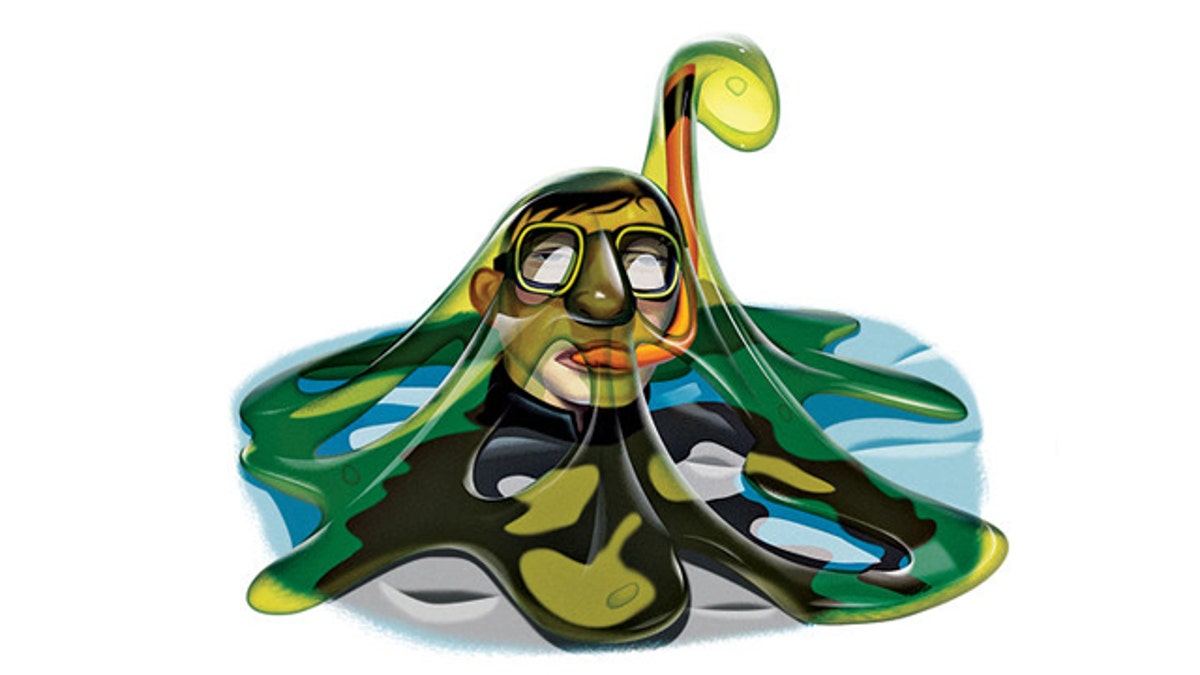
Studying enormous, stinky masses of gelatinous organic material -- or "snot diving" -- is just one of the worst jobs in science. (Nigel Buchanan/Popular Science)
Be grateful that someone else does the hard, dangerous and downright grody work involved in truly audacious science. Here, the worst in jobs science today.
Oceanic-Snot Diver
Every so often, the Mediterranean hocks up a loogie. The balls of mucus, known as “marine mucilage,” are enormous, gelatinous masses of organic material emitted by stressed-out plankton. They harbor everything from dead shrimp to bacteria known to infect humans. Fishermen have encountered the mare sporco (“dirty sea”) off Italy’s eastern coast for centuries.
But the snotballs now appear more frequently, last several months, and sometimes reach over 120 miles in length. Antonio Pusceddu of the Polytechnic University of Marche in Italy and other scientists don scuba gear and jump right in with the foul globs, using large syringes to collect jugs of the material to study in the lab. Pusceddu’s findings indicate that global warming could be putting slime production into overdrive; other scientists worry that overfishing and pollution in the region may contribute to the mucus by disrupting the local ecosystem.
Whatever’s causing it, it’s nasty. “The smell of mucilage can vary depending on the age of these aggregates. At the very beginning, these smell like seafood,” Pusceddu says, “but with time, the smell shifts to the one typically associated with decomposing eggs.”
Bad Dance Observer
It’s no chore to watch supermodels shake it in a nightclub. But Peter J. Lovatt, a former professional dancer and a psychologist at the University of Hertfordshire in England, must examine the often unflattering gyrations of everyone from preteens to the elderly in search of the influences and motivations behind human dancing.
Lovatt and his team record videos of the dancers and then quantify their groove thang using a special movement-analysis technique and software. Other times, observers rate traits such as the overall attractiveness of the dancers’ movements on video, or the observers wear a visor that tracks what elements of the dancer they are looking at. Findings suggest that young women rate the dancing of middle-aged men as less attractive than the dance moves of younger men, perhaps an evolutionary trait that discourages women from choosing older mates—middle-aged men tend to use big, uncoordinated movements, and women typically find complex movement most attractive.
But don’t lose hope. Above age 60, men dance with more complexity. They also exhibit their highest dance confidence at that age. No wonder grandpa thinks he works it so good.
Dung Curator
In the 1970s, Jim Mead started collecting dung from Ice Age critters and modern beasts during his paleological research. By the time he signed on with Northern Arizona University in 1985, he was already hoarding a lot of poo.
Now at East Tennessee State University, Mead hosts what’s believed to be the largest collection of excrement in the world, around 13,000 specimens pinched off by extinct ground sloths, porcupines, you name it. The dung, collected from digs, zoos and various hikes around the world, is dried out and stored in archival-quality cardboard boxes.
When scientists need to identify a piece of dung, they will often send it to Mead for identification. But the collection is more than just a dookie archive; researchers from around the world can pull DNA fragments from the material, use plant matter stuck in the poo to re-create ancient diets (“Look! Corn!”), gather indicators of past climate conditions, and use biochemical markers to determine the gender and health of the animals that left them behind.
Sneeze Modeler
Someone sick sneezes near you, and then you get ill. Obvious, right? But the work done by University of California at Berkeley researcher Mark Nicas and others modeling infection pathways shows that we barely understand how infection works.
The size of the particles coughed onto you matters, as does where they land. That’s why Nicas, under a joint grant from the Department of Homeland Security and the Environmental Protection Agency, has begun a hunt for better data on bursts of mucus and saliva. A volunteer swishes a salt solution before coughing on a plastic face.
Using a chloride-ion detector, Nicas and his assistants can determine how much spittle hits the vulnerable parts of the face. “For 100 years, no one has tried in a good way to measure what fraction of cough fluid would strike the eyes, nose and lips,” he explains. “Information like this currently doesn’t exist.”
For the next six worst jobs in science -- including armpit detective and whale slasher -- see the full story on PopSci.com.
